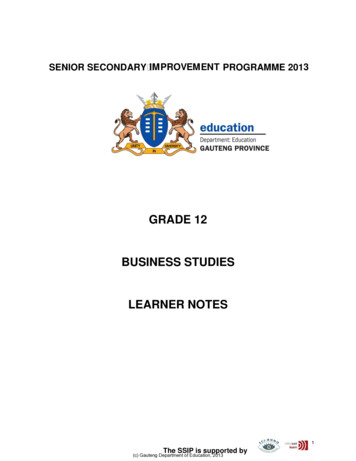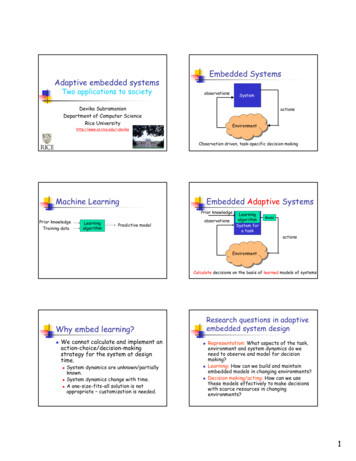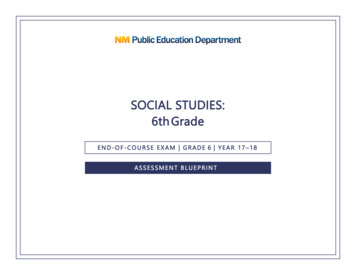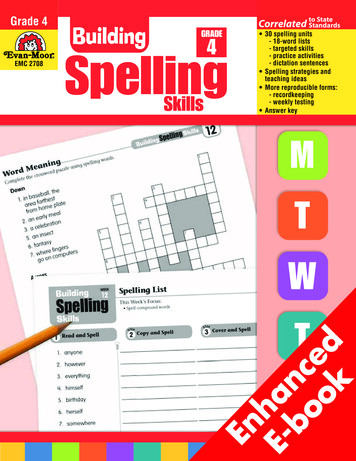
Transcription
SENIOR SECONDARY IMPROVEMENT PROGRAMME 2013GRADE 12BUSINESS STUDIESLEARNER NOTES1The SSIP is supported by(c) Gauteng Department of Education, 2013
TABLE OF CONTENTSLEARNER NOTESSESSION345TOPIC1. Legislation – skills development act (no. 97 of 1998)2. Legislation - the national skills development strategy(NSDS) (1/4/2005 – 31/3/2010) / the human resourcedevelopment strategy1. Entrepreneurial qualities, success factors and areas ofimprovements for a business venture2. Human rights, inclusivity and environmental issues1. InsurancePAGE316412. Investment2(c) Gauteng Department of Education, 2013
GAUTENG DEPARTMENT OF EDUCATIONBUSINESS STUDIESSENIOR SECONDARY INTERVENTION PROGRAMMEGRADE 12SESSION 3(LEARNER NOTES)SESSION 3TOPIC 1: LEGISLATION – SKILLS DEVELOPMENT ACT (NO. 97 OF 1998)Learner Note: All legislation is compulsory. Businesses do not have the option ofnon–compliance, but can develop strategies to accommodate legislation. After the Apartheidregime certain labour legislation had to be introduced or revised. You are required to know allthe provisions of every Act. Study the notes and answer the questions.SECTION A: TYPICAL EXAM QUESTIONS: TOPIC 1QUESTION 1:35 minutes40 marks(DOE Preparatory Exam 2008)HINTS:This is an essay question. Structure is important: Introduction, body and conclusion.Sub-headings are important to use as they count for analysis.Do not write in paragraph style. Use full sentences but in point form.The Skills Development Act has the potential to change the lives of millions ofpreviously disadvantaged people who were deprived of opportunities in educationduring the Apartheid era.You are a front-runner for the development of skills as the human resource manager ofyour company. Convince management about the aims and benefits of this Act andinform them about the purpose and roles of SETAs.QUESTION 2: 5 minutes8 marks[40](DOE Nov. 2010)HINTS: The motivation in this question means that you should use examples. 2 marks for factand 1 mark for motivation.How does the National Skills Development Strategy (NSDS) deal with theshortage of skills in the labour market? Motivate your answer.[8]3(c) Gauteng Department of Education, 2013
GAUTENG DEPARTMENT OF EDUCATIONBUSINESS STUDIESSENIOR SECONDARY INTERVENTION PROGRAMMEGRADE 12SESSION 3(LEARNER NOTES)TOPIC 2: LEGISLATION - THE NATIONAL SKILLS DEVELOPMENT STRATEGY (NSDS)(1/4/2005 – 31/3/2010) / THE HUMAN RESOURCE DEVELOPMENT STRATEGYSECTION A: TYPICAL EXAM QUESTIONS: TOPIC 2QUESTION 1:10 minutes10 marks(DOE Nov. 2008)HINTS: The examples that are required are the names of any 2 SETAs.The following questions are based on SETA (Sector Education and Training Authority):1.1 Explain the contribution of SETAs towards ensuring that quality skills developmenttakes place. Illustrate by using any TWO examples.1.2 Describe how SETAs are funded.QUESTION 2:20 minutes20 marks(8)(2)[10](DOE Preparatory 2008)HINTS: You need to know the % contribution by business towards the SDL in order tocalculate the amount in Q 2.2.Zandile was awarded a license to extract timber from the Ngodini forest near Nelspruit. Sheuses 100 trucks to transport the timber and has 1 500 employees. The monthly salary andwage bill of Zandile's business is R6 400 000. The factory processes the timber into semifinished products in the form of planks which are sold to furniture manufacturers as well as thebuilding industry.2.12.22.32.4Does Zandile’s business qualify for paying the Skills DevelopmentLevy? Motivate.(5)Use the information above to calculate the amount that Zandile's factory willpay for skills levy every month. (Show ALL the calculations.)(4)Explain the procedures to be followed if a dispute arises between Zandile’sbusiness and the SETA.(10)To which economic sector would the extraction of timber be classified?(1)[20]4(c) Gauteng Department of Education, 2013
GAUTENG DEPARTMENT OF EDUCATIONBUSINESS STUDIESQUESTION 3:SENIOR SECONDARY INTERVENTION PROGRAMMEGRADE 1210 minutesSESSION 310 marks(LEARNER NOTES)(Various sources)Discuss the objectives of The National Skills Development Strategy.[10]SECTION B: ADDITIONAL CONTENT NOTES: TOPIC 1Purpose of the Skills Development Act is to: develop the skills of the South African workforce.encourage employers to: use the workplace as an active learning environment. provide employees with the opportunities to acquire new skills. provide opportunities for new entrants to the labour market to gain workexperience employ persons who find it difficult to be employed.encourage workers to participate in learnerships and other training programmes.ensure quality of education and training in the workplace.assist work seekers to find employment, retrenched workers to re-enter the labourmarket and employers to find qualified employees.improve the employment prospects of persons previously disadvantaged by unfairdiscrimination, and to redress those disadvantages through education and training.improve the quality of life of workers as well as career possibilities.improve productivity in the workplace and the competitiveness of employees.promote self-employment.improve the creation of social services.increase the levels of investment in education and training in the labour marketand to improve the return on that investment.provide and regulate employment services.Paying the Skills Development Levy An employer must pay a skills development levy of 1% of the total amount paid insalaries to employees every month, if: the employer has registered the employees with SARS and/or the employer pays over a certain threshold per annum ( R500 000 as of June 2010) in salaries and wages to their employees.The levies paid to SARS are put in a special fund.20% of this fund will be paid into the National Skills Fund.The National Skills Fund is administered by the Director General.The National Skills Fund will fund skills development projects that don’t fall underSETAs.5(c) Gauteng Department of Education, 2013
GAUTENG DEPARTMENT OF EDUCATIONBUSINESS STUDIESGRADE 12SENIOR SECONDARY INTERVENTION PROGRAMMESESSION 3(LEARNER NOTES)Who is exempt from payment of SDL? Public service institutions Religious or charity organisations Public entities that get more than 80% of their money from Parliament Employers: whose total pay to all its workers is less than R500 000 per 12 month period who do not have to register according to the Income Tax Act.Sectorial Education and Training Authority - SETA This is an organisational institution which implements the skills plan in that specificsector, in collaboration with the trade unions of that sector.They are active in all economic sectors.Each economic sector has one SETA.There are 27 SETAs which cover all work sectors in South Africa.SETAs are responsible for developing and implementing skills development plans.They must control the education standards of the labour force in that specific sector.SETAs determine, in collaboration with businesses in that sector, the needs for certainskills that must be developed.SETAs do the selection and appointment of service providers who will develop the skillsprogrammes, in that specific sector.They control the quality of education and training to meet the specific skills to bedeveloped.Financing of SETAs’ The SETAs’ receive 80% of the funds collected from the skills development levies.Money paid to the SETA from the National Skills Fund.Grants, donations and bequests made to the SETA.Income earned on surplus money deposited or invested.Income earned on services rendered.Money received from any other source.These funds are administered by the Director-General and must be audited.Functions of SETAs / Aim of SETAs/ Role of SETAs Develop a skill plan for that specific sector within the framework of the National SkillsDevelopment Strategy.Implement its sector skills plan by: establishing learnerships. approving workplace skills plans. allocating grants in the prescribed manner to employers, education and trainingproviders. monitoring education and training in the sector.6(c) Gauteng Department of Education, 2013
GAUTENG DEPARTMENT OF EDUCATIONBUSINESS STUDIES GRADE 12SENIOR SECONDARY INTERVENTION PROGRAMMESESSION 3(LEARNER NOTES)Promote learnerships by:identifying workplaces for practical work experience. improving the facilitation for learning. assisting in the conclusion of learnership agreements.Liaise with the National Skills Authority on: the national skills development policy the national skills development strategy the skill plan for that sectorSupporting the development of training materialsResponsible for quality control in trainingEnsuring that required skills are availableRegistration of learnership agreementsWithin a week from its establishment, apply to the SAQA for accreditation. Must beaccredited within 18 months of application.Collect and disburse the skills development levies in its sector.Businesses who make use of training programmes through the SETAs, may claim agrant from the SETA after auditing the number of workers trained, as well as their race,gender, etc.Report to the Director-General on: its income and expenditure. the implementation of its sector skills plan.Appoint staff needed for the performance of its functions. Examples of SETAsW&RSETABANKSETATHETACHIETAESETAWholesale and Retail Sector Education and Training AuthorityBanking Sector Education and Training AuthorityTourism and Hospitality Education and Training AuthorityChemical Industry Education and Training AuthorityEnergy Sector Education and Training AuthoritySECTION B: ADDITIONAL CONTENT NOTES: TOPIC 2Learnerships: An approved institution providing a skills programme for workers in a specific sector.This programme must give workers the opportunity to learn a specific occupation whilethey are employed in that specific sector.Their quality of work must be assessed by the specific SETA.7(c) Gauteng Department of Education, 2013
GAUTENG DEPARTMENT OF EDUCATIONBUSINESS STUDIESGRADE 12SENIOR SECONDARY INTERVENTION PROGRAMMESESSION 3(LEARNER NOTES)Conditions under which a learnership may be established: The learnership consists of a structured learning componentThis should include practical work experience of a specific nature and duration.The learnership would lead to a qualification registered by SAQA and related to anoccupation.The intended learnership is registered with the Director-General in the prescribedmanner.Procedure to follow when disputes arise between the SETA, employer and employee: Any party who wants to declare a dispute, must refer in writing to the CCMA.The party who declares the dispute, must satisfy the Commission that a copy of thereferral has been served on all the other parties involved in the dispute.The Commission must attempt to resolve the dispute through conciliation.If the dispute remains unsolved, any party may request that the dispute be resolvedthrough arbitration as soon as possible.Legislation related to the lawfulness and unfair dismissal must be applied.Problems resulting from this Act: It is difficult to assess the contribution of the SETAs towards skills development.Difficult to assess the performance of the various SETAs.Many businesses who contribute cannot afford to send employees on training due towork and time constraints.To claim back from relevant SETA involves administrative work.Leads to increased costs and paperwork for business enterprises that contributetowards the National Skills Fund.Workers need regular training to meet the demand of a dynamic working environmentand this will influence continuity in the workplace.Advantages of this Act: Developing skills of employees that are required by employers.Improving employment opportunities for workers.Giving workers opportunities in the marketplace by equipping them with useful skills.Promoting overall efficiency in the workplace.Trained employees are more productive.Addresses discrimination through training.SOUTH AFRICAN QUALIFICATIONS AUTHORITY ACT, 1995 (SAQA)Purpose: Control training delivered through the service providers of the different SETAs. Registration of SETAs Keep a register of qualifications by learners achieved through the different SETAs toprevent fraud of qualifications.8(c) Gauteng Department of Education, 2013
GAUTENG DEPARTMENT OF EDUCATIONBUSINESS STUDIESSENIOR SECONDARY INTERVENTION PROGRAMMEGRADE 12SESSION 3(LEARNER NOTES)THE NATIONAL SKILLS DEVELOPMENT STRATEGY (NSDS) (1/4/2005 – 31/3/2010)Principles: Support economic growth through employment creation and poverty eradication.Promote productive citizenship.Accelerate BBBEE and Employment Equity (85% Black, 54% women and 4% peoplewith disabilities).Support, monitor and evaluate the quality assurance systems necessary toimplement NSDS.Advance the culture of excellence in skills development and lifelong learning.Objectives: Prioritising and communicating critical skills for sustainable growth, development andequity.Improving the quality and relevance of provision of training and education and skillsdevelopment.Promoting and accelerating quality training for all in the workplace.Assisting designated groups to acquire critical skills to enter the labour market andself-employment.Promoting employability and sustainable livelihoods through skills development.The Human Resource Development StrategyKey mission - To implement a plan: to maximise the potential of all South Africans through the acquisition of knowledge andskills;to work productively and competitively to a rising quality of life for all.Objectives: Improving the foundation for human developmentImproving the supply of skillsIncreasing employer participation in lifelong learningSupporting employment growth through innovation and researchEnsuring that the four objectives are linked9(c) Gauteng Department of Education, 2013
GAUTENG DEPARTMENT OF EDUCATIONBUSINESS STUDIESSENIOR SECONDARY INTERVENTION PROGRAMMEGRADE 12SESSION 3(LEARNER NOTES)SECTION C: HOMEWORKQUESTION 1:5 minutes6 marks(Sunday Times Avusa 2009)Four possible options are provided as answers to the following questions. Choose the correctanswer and write only the letter (A – D) next to the question number, for example 1.7 B1.11% of the wage bill of every business must go towards A. Skill Development ActB. Employment EquityC. SETAD. BEE1.2(2)This organisation is responsible for developing standards and qualifications criteria forthe National Qualifications Framework (NQF).(2)A. SETAsB. FET collegesC. LearnershipsD. SAQA1.3Learnerships in insurance is offered by the .A South African Reserve Bank (SARB).B Industrial Development Corporation (IDC).C Sector Education and Training Authority (SETA).D Manpower Commission.QUESTION 2:15 minutes12 marks(2)[6](DOE Exemplar 2008)Explain the purpose of the Skills Development Act, 1998 (Act 97 of 1998) andcomment on the progress of this Act in industry.QUESTION 3:10 minutes12 marksDiscuss the objectives of The Human Resource Development Strategy.[12](Various Sources)[10]10(c) Gauteng Department of Education, 2013
GAUTENG DEPARTMENT OF EDUCATIONBUSINESS STUDIESSENIOR SECONDARY INTERVENTION PROGRAMMEGRADE 12SESSION 3(LEARNER NOTES)SECTION D: SOLUTIONS AND HINTS TO SECTION A – TOPIC 1QUESTION 1IntroductionSETA - Sector Education and Training Act. SETAs are here to stay and it is only to the benefit of employers to make use ofthe training programmes which are offered by the various SETAs. Any other relevant comment ( any 1 x 3 ) (3)Content / BodyThe aim of the Skill Development Act no. 97: Rectify the imbalances of the past. To improve the level of investment in educating and training in the workforce. To use the work place as a learning environment. To encourage to take part in leadership. To improve employment opportunities of disadvantaged people. To ensure quality training and education in the work place- this implies. that any training programme to be offered, must first be accredited. Assist job seekers to find work, retrenched workers to return to labour market. To provide and regulate employment services. To encourage employers to participate in learnerships. Any other relevant answer. (any 6 x 2) (12)Benefits of the Skills Development Act No. 97 It ensures core levels of training to be consistent with the skill requirementsof the labour market. It alleviates the free-rider problem thereby ensuring that all businessescontribute to the cost of training. It improves collection efficiency - collection of the levy bySouth African Revenue Services will improve compliance. It promotes training effectiveness and efficiency. It ensures multipartite participation from employers and employees in theGovernance of training and education funds. Any other relevant answers. (any 5 x 2) (10)Purpose of SETAs SETAs were established as implementing agencies of the skill developmentstrategies or to replace the Industry Training Boards. (any 1 x 3) (3)11(c) Gauteng Department of Education, 2013
GAUTENG DEPARTMENT OF EDUCATIONBUSINESS STUDIESGRADE 12SENIOR SECONDARY INTERVENTION PROGRAMMESESSION 3(LEARNER NOTES)Roles of SETAs To collect funds. To distribute the funds to the National Skill Fund and various SETA’. To implement learnerships and skill programmes that replaced the tradition asapprenticeship. To develop a sector skills plan. To report to the Director General. To support the development of training material. Any other relevant answer. (any 5 x 2) (10)6.3 ConclusionThe services which SETAs offer do not only benefit the employees but also theemployer. (2)Breakdown of mark allocation:IntroductionContent:Aim of Skills Development ActBenefits Skills Development ActPurpose of SETAsRole of SETAsConclusion31210310240 (max 32)Insight:StructureSynthesisAnalysis and InterpretationOriginality, examples and recency22228 (max 8)(32 8) [40]QUESTION 2Option 1- Use skills development. Promote sustainable livelihood and employability. - Providers of education and training. Should comply with the minimum quality assurance standards whenthey offer skills programs and workshops. - Ensures that quality training takes place in the workplace. Requires reports.Assist people who want to be self employed. Acquires the necessary skills. - To ensure critical skills for development. Sustainable growth and equity. - Promote economic growth. This leads to job creation and poverty alleviation. - Creates a database. Assists in identifying skills related to market demand. 12(c) Gauteng Department of Education, 2013
GAUTENG DEPARTMENT OF EDUCATIONBUSINESS STUDIESGRADE 12SENIOR SECONDARY INTERVENTION PROGRAMMESESSION 3(LEARNER NOTES)- Provides for the establishment of SETAs. Implementation of learnerships. - Unlike the Manpower Act, Skills Development is now enhanced by SETAs for all sectors. - Any other relevant answer related to theobjectives/purpose/benefits of the National Skills DevelopmentStrategy.- Consider relevant information from the Skills Development Act(Any 3 x 3) (9)Max. [8]Option 2By providing skills development more people will be skilled or any rationale onNSDS.Rationale: Promotes skills development or any rationale on NSDS.Motivation:- Use skills development. - Providers of education and training. - Ensures that quality training takes place in the workplace. - Assist people who want to be self employed. - To ensure critical skills for development. - Promote economic growth. - Creates a database. - Provides for the establishment of SETAs. - Any other relevant answer related to the objectives/purpose/benefits of theNational Skills Development Strategy.Rationale: (2)Motivation (Any 3 x 2) (6)Max.[8]SECTION D: SOLUTIONS AND HINTS TO SECTION A – TOPIC 2QUESTION 11.1 Explain the contribution of SETAs towards ensuring that quality skillsdevelopment takes place. Illustrate by using any TWO examples.- Manage the learnerships and training in each SETA sector. - Ensure that skills requirements of different sectors are identified. - Ensure that training is of the appropriate quality. - Responsible for skills programmes to improve skills of current workers. - Assist unemployed people to enter the job market by providing skills programmes. - Provide accreditation to facilitators and training providers.- Any other relevant skills development programme. (any 2 x 2) (4)13(c) Gauteng Department of Education, 2013
GAUTENG DEPARTMENT OF EDUCATIONBUSINESS STUDIESGRADE 12SENIOR SECONDARY INTERVENTION PROGRAMMESESSION 3(LEARNER NOTES)EXAMPLES:SETA- Engineering which provides training and skills development in theengineering field e.g. Electronic engineering. - Office Administration which provides training and skillsdevelopment to Secretaries and Office Assistants in office work. - MQA – Mining Qualifications Authority. - INSETA – Insurance Sector. - HWSETA – Health and Welfare Sector. - FOODBEV – Food and Beverages Manufacturing Sector. - FASSET – Financial and Accounting Service Sector. - ETDP – Education Training and Development Practices. - CTFL – Clothing, Textile, Footware and Leather Sector. - CETA – Construction Sector. - PSETA – Public Sector. - SERVICES SETA – Services Sector. - THETA – Tourism and Hospitality and Sport Sectors. - W & R SETA – Wholesale and Retail Sector. - CHIETA – Chemical Industry Education Training Authority. - ISETT- Information System, Electronic and TelecommunicationTechnology. Any other relevant SETA.ACCEPT: Acronyms or Full details.(any 2 x 2) (4)Contributions Max 4Example Max 41.2 Describe how SETAs are fundedReceive 80% of the funds collected from the Skills Development Levy thatqualifying businesses must pay. - Employers pay a monthly levy equivalent to 1% of the total salary and wageexpense of the business. Increase in income from services rendered by Setas. - Grants, donations and bequests. - Funding from the National Skills Development Fund. - Income from surplus funds invested. Actual percentage is not necessary.(any 1 x 2) (2)[10]QUESTION 22.12.2Yes Motivation – Her monthly wage bill is R6 400 000 Monthly salary and wage bill X skills levy of 1%6 400 000 X 1/100 R64 000 Answer only without any calculations allocate 2 marks.(5)(4)14(c) Gauteng Department of Education, 2013
GAUTENG DEPARTMENT OF EDUCATIONBUSINESS STUDIESGRADE 12SENIOR SECONDARY INTERVENTION PROGRAMMESESSION 3(LEARNER NOTES)2.3 Any party who wants to declare a dispute, must refer in writing to the CCMA. The party who declares the dispute must satisfy the Commission that a copy of thereferral has been served on all the other parties involved in the dispute. The Commission must attempt to resolve the dispute through conciliation. If the dispute remains unsolved, any party may request that the dispute be resolvedthrough arbitration as soon as possible. Legislation related to the lawfulness and unfair dismissal must be applied. (5x2) (10)Primary Sector 2.4(1)[20]QUESTION 3 Prioritising and communicating critical skills for sustainable growth, development andequity. Improving the quality and relevance of provision of training and education and skillsdevelopment. Promoting and accelerating quality training for all in the workplace. Assisting designated groups to acquire critical skills to enter the labour market andself-employment. Promoting employability and sustainable livelihoods through skills development. (5 x 2) [10]15(c) Gauteng Department of Education, 2013
GAUTENG DEPARTMENT OF EDUCATIONBUSINESS STUDIESSENIOR SECONDARY INTERVENTION PROGRAMMEGRADE 12SESSION 4(LEARNER NOTES)SESSION 4TOPIC 1: ENTREPRENEURIAL QUALITIES, SUCCESS FACTORS AND AREAS OFIMPROVEMENTS FOR A BUSINESS VENTURE.Learner Note: Although many entrepreneurs are born entrepreneurs, entrepreneurialqualities can be developed or improved. Many entrepreneurs are so involved that they tend toignore the qualities that need to be worked on, and it is these very qualities that can bringthem down. Entrepreneurial qualities can be success factors for a business but there aremany other factors that could lead to a businesses success.SECTION A: TYPICAL EXAM QUESTIONS – TOPIC 1QUESTION 1:30 minutes40 marks(DOE Mar. 2010)There is no magic formula for entrepreneurship. Although there are many different andsuccessful approaches to business success, it is the power of good entrepreneurial qualitiesthat will finally determine the level of performance a particular business venture will attain.Explain any FIVE entrepreneurial qualities of a successful business enterprise. Discuss howkey success factors, such as sustainability, profitability and the customer base, can influencethe overall performance of any business venture.[40]HINTS:This is an essay question. Structure is important: Introduction, body and conclusion.Sub-headings are important to use as they count for analysis.Do not write in paragraph style. Use full sentences but in point form.Use current examples of entrepreneurs to obtain marks for originality.QUESTION 2:10 minutes12 marks(Nov. 2008)Read the extract below and answer the question that follows.Are You Entrepreneurial Material?Entrepreneurs are 1. optimistic and goal-setting people who have a strong focus on results.2. able to rely on themselves and have a great deal of confidence, determination anddedication to do the best at all times.3. able to interact effectively with people.4. positive, pleasant and eager to meet people and satisfy them.5. inquisitive, intuitive and enjoy new challenges.6. ambitious and have the ability to judge and act on incomplete information.[Adapted from: Succeed, December 2006]Analyse any THREE qualities of a successful entrepreneur.Use the examples from the extract to support your answer.[12]HINTS: Remember to use characteristics with examples from the extract. 2 marks for qualityof answer, and 2 marks for the example.16(c) Gauteng Department of Education, 2013
GAUTENG DEPARTMENT OF EDUCATIONBUSINESS STUDIESSENIOR SECONDARY INTERVENTION PROGRAMMEGRADE 12SESSION 4(LEARNER NOTES)TOPIC 2: HUMAN RIGHTS, INCLUSIVITY, AND ENVIRONMENTAL ISSUES.Learner Note: Business enterprises are facing constant pressure not only to be profitable,but also to contribute towards human rights, inclusivity and environmental issues.Business enterprises are assessed against these criteria (human rights, inclusivity andenvironmental issues) to ensure that all enterprises compete on an equal basis.SECTION A: TYPICAL EXAM QUESTIONS – TOPIC 2QUESTION 1:15 minutes18 marks(DOE Nov. 2010)Discuss how businesses in South Africa can contribute to human rights,inclusivity and environmental issues in the workplace.[18]HINTS: The mark allocation is 18 marks so you should write for 6 marks per issue. Thismeans that every issue should have two facts and an example - 2 marks for fact and 1 markfor an example.QUESTION 2:10 minutes8 marks(DOE Mar. 2009)Discrimination in the workplace is one of the human rights issues that has a negative impacton the relationship between employers and employees.2.1 Do you agree or disagree with this statement? Motivate your answer.(4)2.2 Indicate how discrimination can be resolved in the workplace.(4)[8]HINTS: Question 2.1 needs motivation to earn marks. No motivation, no marks.17(c) Gauteng Department of Education, 2013
GAUTENG DEPARTMENT OF EDUCATIONBUSINESS STUDIESQUESTION 3:SENIOR SECONDARY INTERVENTION PROGRAMMEGRADE 1210 minutesSESSION 48 marks(LEARNER NOTES)(DOE Preperatory 2008)Study the extract from an interview below and answer the question that follows.INTERVIEW WITH A TEACHERQ: What does your career involve?A: Teaching subject content to learners, assessing their progress, coaching sport,counselling learners with personal problems or family issues, rehearsing dramasand supervising fundraising activities to mention but a few.Q: What do you like about your job?A: I enjoy working with young people and seeing them lighting up when learningsomething new, or understanding a difficult concept, and achieving their goals.Q: What does creativity mean in your job?A: You often have problems finding information or resources to use for teaching yourlearning area. Therefore, you learn to use all resources that you can lay your hands on,very creatively to teach your learners.Q: How do team dynamics influence your workplace?A: It is important that all staff members work as a team. This ensures that all thelearners are taught well, and they all have the opportunity to reach theirgoals and perform according to their abilities.Q: What advice can you give learners who are interested in following a similar career path?A: To be a teacher you have to love working with people, be diligent, competent,honest, reliable, compassionate, extremely hardworking and diverse.Q: Should teachers be respectful toward colleagues?A. Yes, every teacher must understand human rights issues and how to implementthem in the workplace.Employers and employees should promote basic human rights in the workplace. IdentifyFOUR examples of these rights.[8]HINTS: Always remember that if the answers to these human rights are not in the text, youshould know them from what you have learned in the notes.SECTION B: ADDITIONAL CONTENT NOTES – TOPIC 1Defining an EntrepreneurEntrepreneurship is one of the four factors of production.Entrepreneurs are responsible for combining the other three factors of production(labour, capital and natural resources).They are able to see a business opportunity and have the ability and courage to change thisopportunity into a profitable business.This allows them to earn profits and create jobs for others.18(c) Gauteng Department of Education, 2013
GAUTENG DEPARTMENT OF EDUCATIONBUSINESS STUDIESGRADE 12SENIOR SECONDARY INTERVENTION PROGRAMMESESSION 4(LEARNER NOTES)Important entrepreneurial qualities are:
gauteng department of education senior secondary intervention programme business studies grade 12 session 3 (learner notes)










